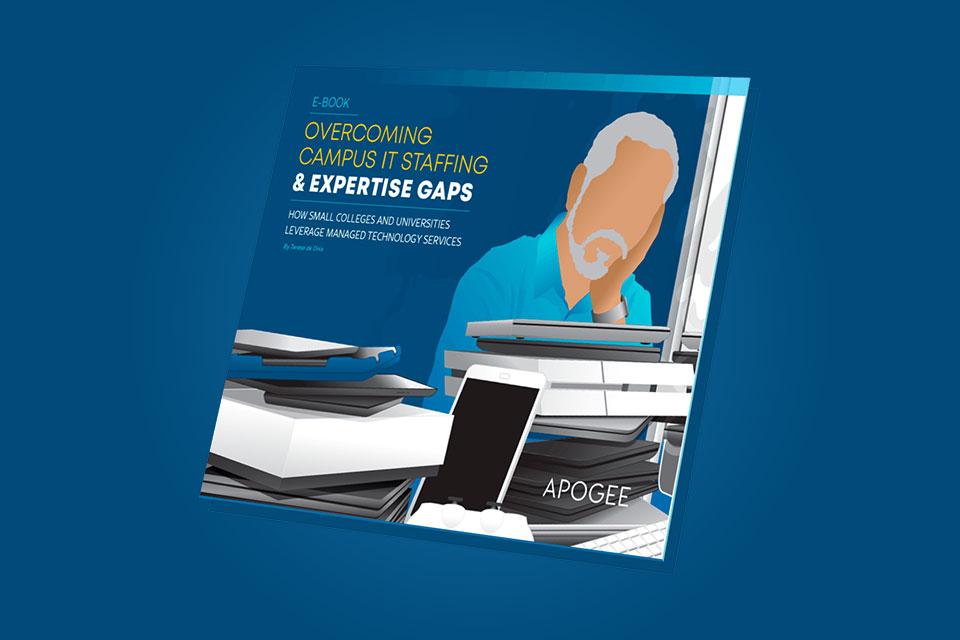Pivot from Great Resignation to Great Retention
The low unemployment rate and the Great Resignation (also known as the Big Quit or Great Realignment) are contributing to an unprecedented shortage of experienced IT professionals. Higher education has traditionally offered lower salaries for these roles, so recruiting talent within budget constraints has become tricky. Understaffed IT teams are working on a growing list of projects and tasks, and campus leaders may not have the budget to pivot to a Great Retention. Turnover means CIOs and IT directors are spending time and money recruiting, hiring, and training new employees instead of the important work of leading digital transformation.
In addition, we are on the cusp of a population decline of 18–24-year-olds in 2025. Because people had fewer children during the Great Recession in 2008, the number of 18-year-olds graduating from high school is expected to fall nationally after 2025 by 11 to 15 percent, according to estimates by Western Interstate Commission for Higher Education (WICHE) and Carleton College economist Nathan Grawe, respectively.
It is a strange mix of forces that, combined with the federal COVID-19 relief funds’ expiration in June 2023, threatens higher education once again.
What’s next? The pandemic after-effects will likely be long-lasting. Students now demand more flexibility in how and where they take classes. They have won some relief from student loan debt. They want to be better prepared for the real world of work. And colleges and universities know they must continue to innovate and get smarter about the delivery of education to face the economic uncertainty and population drop.
Higher ed began transforming in the wake of the pandemic, and now is the time to capitalize on that momentum.
This e-book presents the results of a survey Apogee conducted in late 2021 of 188 campus IT professionals across all school sizes, private and public, and provides a roadmap to harness your innovation momentum from a managed technology services provider’s perspective. We will focus on the needs of IT departments and how the struggle with the shortage of campus IT staff and expertise is inhibiting innovation and smarter IT strategies and decisions. Apogee has a 22-year history solely serving higher education. We partner with nearly 400 institutions and serve over one million students, and we believe there are some steps you can take to address the IT talent crisis and embed a culture of innovation and smart decision-making in the next two years. Let’s dive in.
The State of Campus IT at Small Colleges and Universities
In October 2021, Apogee conducted a survey of 188 US higher education IT professionals in private and public non-profit institutions, with a 40/60 split, respectively. Here is the breakdown of their roles (Fig 1), and their tenure in higher ed IT (Fig 2):
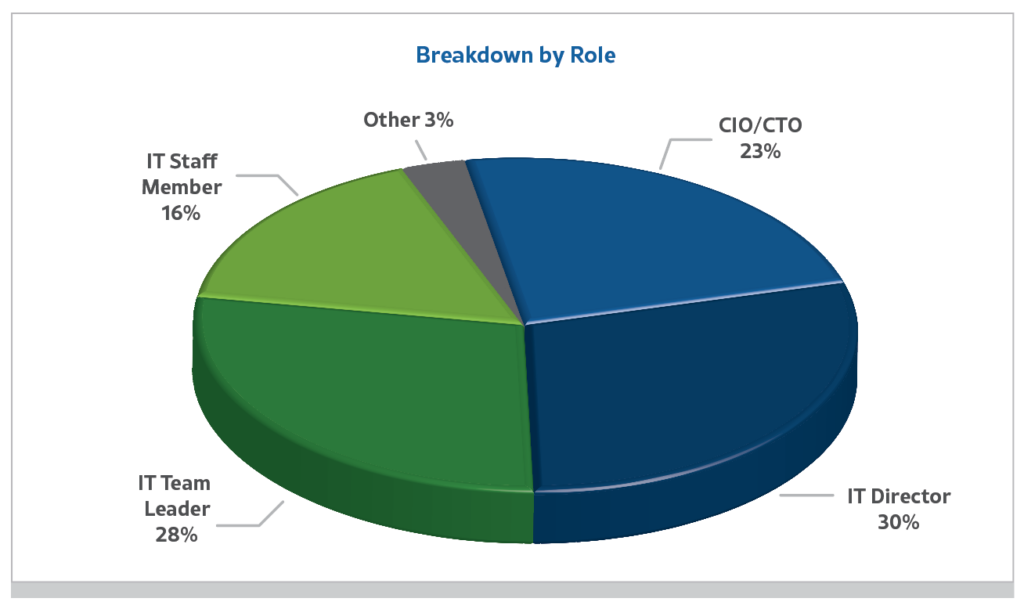
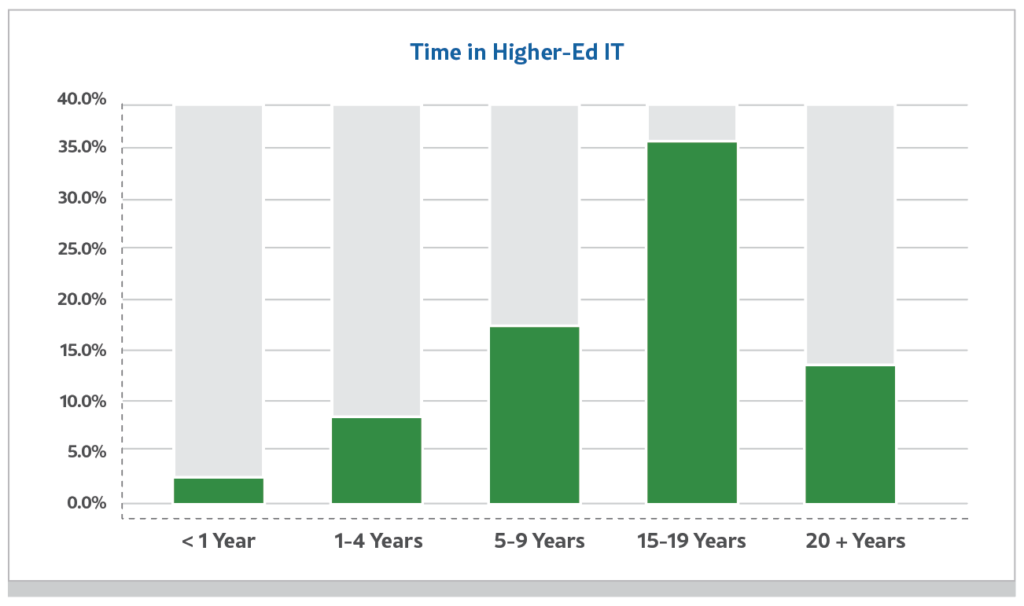
IT pro respondents were from a mix of school sizes (from an enrollment standpoint), providing good representation across all different types of school sizes (Fig 3), with 44 percent from schools with less than 5000 enrollment, and 56 percent from schools over 5,000 enrollment.
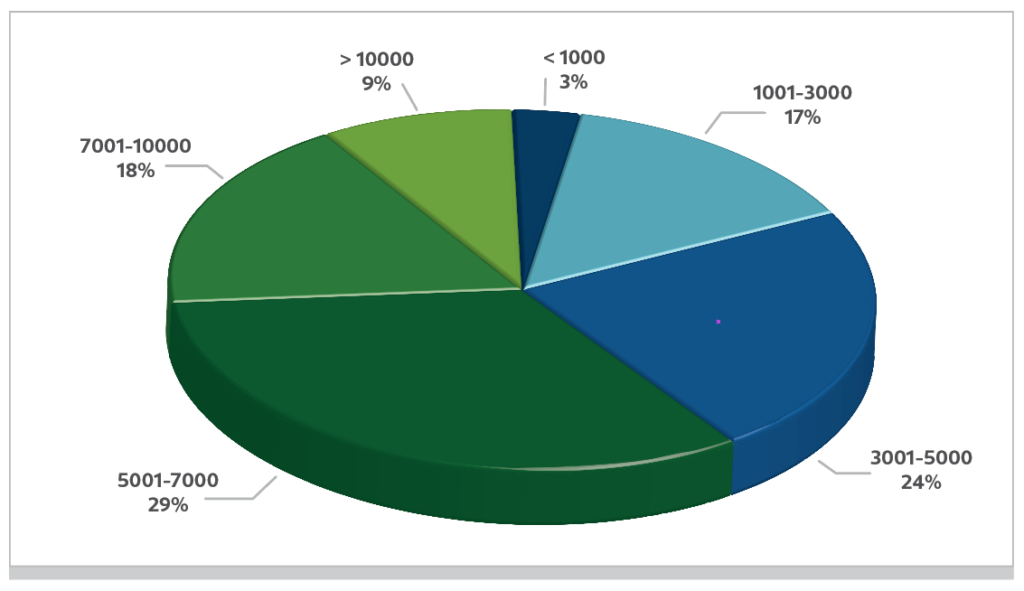
In this e-book, we will focus on schools with less than 5,000 enrollment and walk you through five key insights. The next section will provide some actionable steps you can take if you recognize yourself and your institution in the data.
1. Campus IT teams feel
supported by senior leadership.
Fifty-five percent of the campus IT pros in our survey feel that senior leadership works hard to get them the resources they need, while 17 percent strongly disagree that they do (Fig 4). This is a positive sign that institutions are collaborating and developing productive and loyal teams that can deliver effective results for student retention and satisfaction.
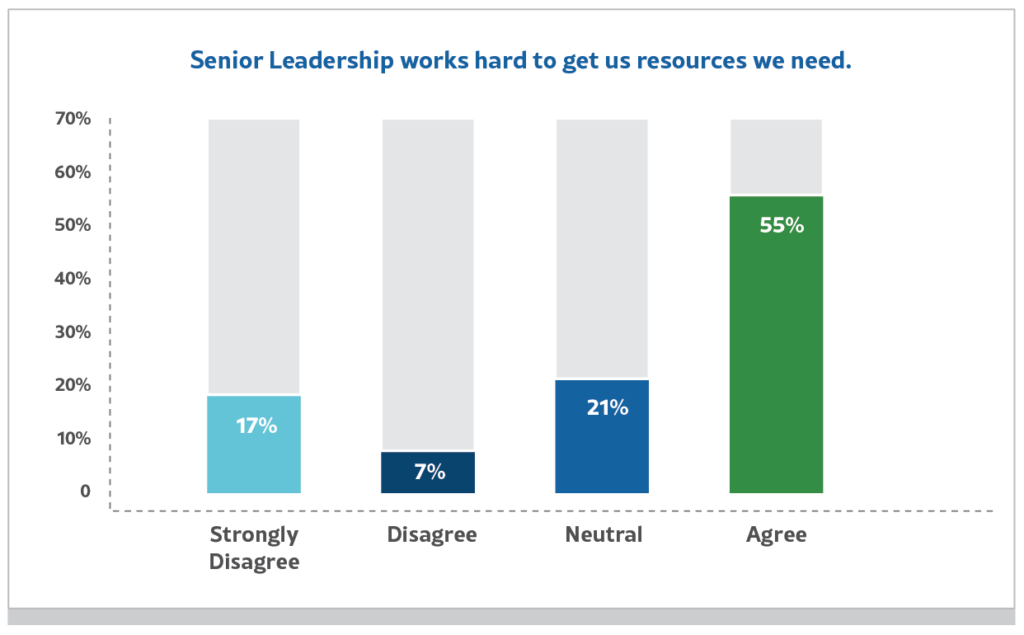
2. But getting financial
resources is still difficult.
Forty-six percent of campus IT pros indicated that getting financial resources for their department needs is somewhat difficult (34 percent) or extremely difficult (12 percent) (Fig 5). Schools with enrollment in the 1500-5000 range felt this difficulty more acutely, with 53 percent of that sub-group reporting that obtaining financial resources was somewhat or extremely difficult.
One of the main reasons IT initiatives fail is due to discrepancies regarding economic resources, labor, and material. Institutions that are unable to allocate and manage project resources properly experience problems that affect their day-to-day operations, long-term strategies, and financial health.
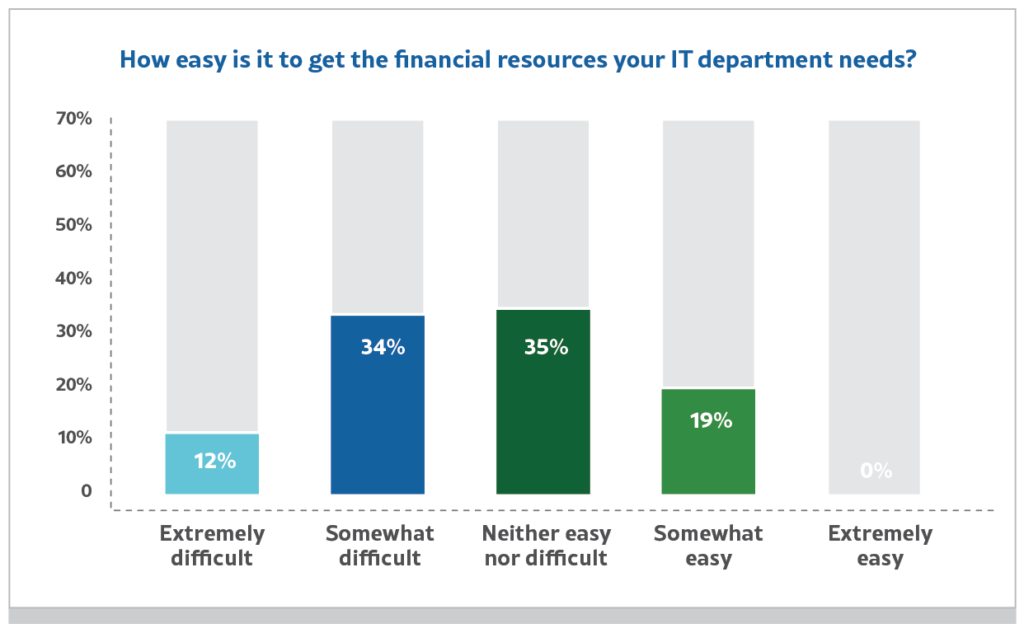
3. Campus IT teams feel
squeezed and overworked.
Fifty percent of the IT pros responded that they are way understaffed and struggle to keep up (18 percent) or could use one or two more people to help (32 percent) (Fig 6). While 37 percent of respondents said they have plenty of staff, the majority of those (62 percent) are from schools with 1500-5000 enrollment.
Understaffing leads to overwhelm and burnout. Burnout symptoms start to appear after prolonged periods of too much workload and elevated stress levels. Normally engaged teams become disaffected and detached. Productivity declines, targets are missed, and usually enthusiastic team members become apathetic and feel hopeless.
Understaffing also makes it difficult to get smart about priorities, as everyone is scrambling to keep their heads above water.
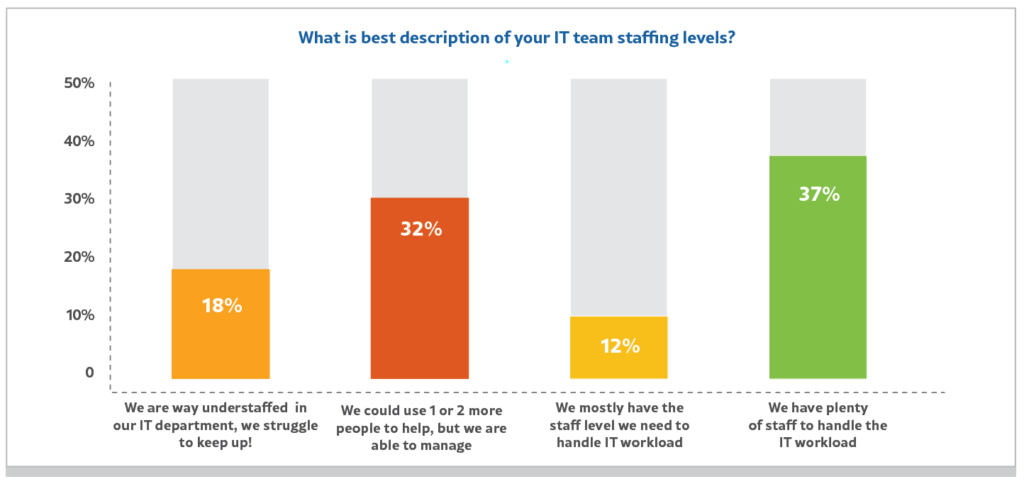
4. Campus IT teams report frequent staff turnover.
While institutions with less than 1500 enrollment are more likely to report frequent IT staff turnover, this is an issue for schools of all sizes, with 85 percent of respondents reporting some (42 percent), frequent (24 percent), or very frequent (19 percent) turnover (Fig 7).
The impact of frequent turnover cannot be overstated. The immediate consequences can be severe: loss of valuable knowledge and experience, loss of morale for those left, and loss of belief in the team’s competence and ability to perform. None of those are quick or easy to replace.
In addition, CIOs must spend time and money training new employees on routine tasks or searching for employees to fill vacancies.
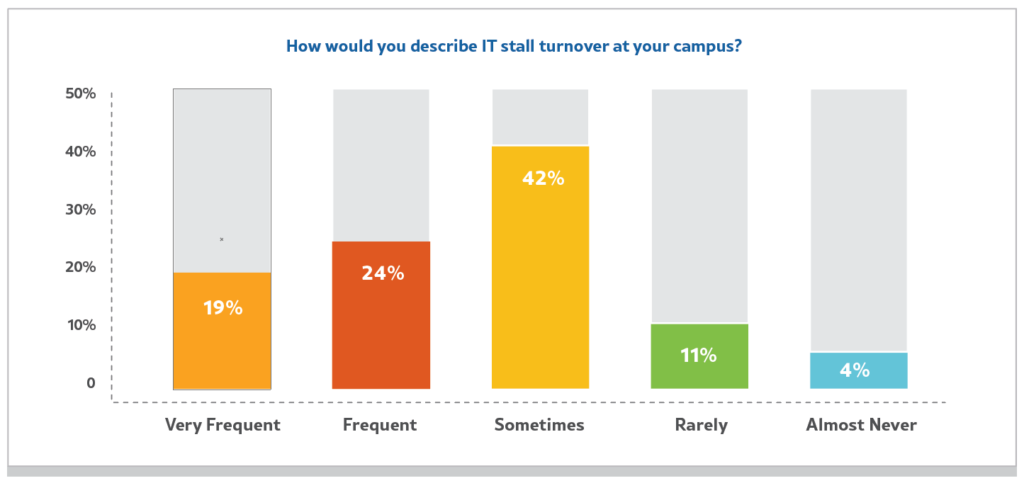
5. The staffing deficit has created another problem – less experienced staff.
Forty-seven percent of IT staff are generalists, 18 percent are a mix of specialists and generalists, and just 35 percent are specialists (Fig 8). Being a specialist is priceless. An IT specialist has a huge advantage when it comes to problem solving because they know the ins and outs of their craft and can predict upcoming changes in the industry. CIOs look for depth of skill in a particular field, and specialists are valuable resources when specific problems arise.
The lack of employees with the expertise needed to deploy more robust IT projects can be a major roadblock to innovation in higher education. Many institutions are having trouble recruiting talent and cannot afford to hire experienced IT pros. We see this in the ratio of rookies to veterans at our respondents’ institutions, where only 18 percent reported that their IT team is mostly veterans (11 percent) or all veterans (7 percent), and 42 percent are all rookies or mostly rookies.
While rookies are more likely to ask for help and listen, campus IT teams that weigh heavily in that direction could be lacking the experience needed to make strategic and smart IT decisions.
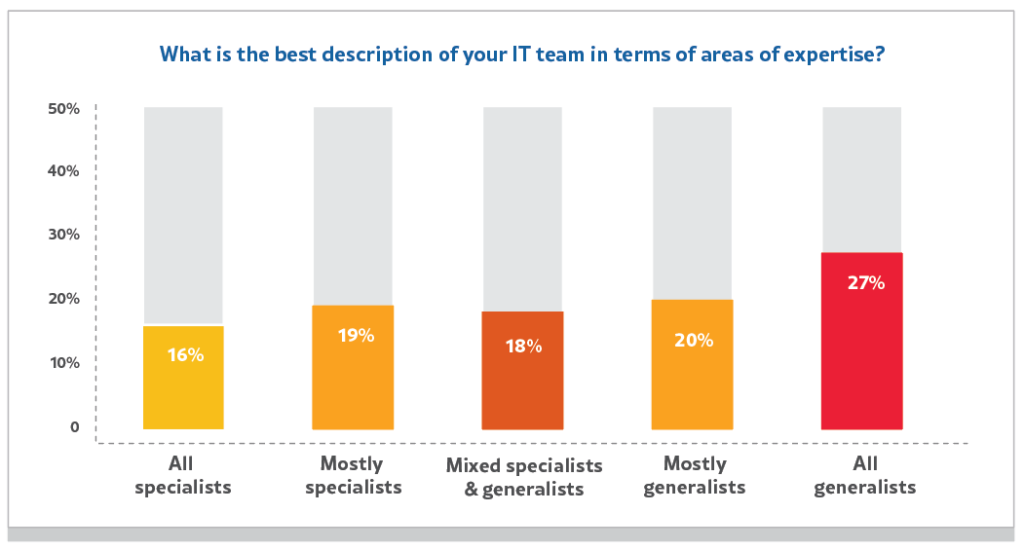
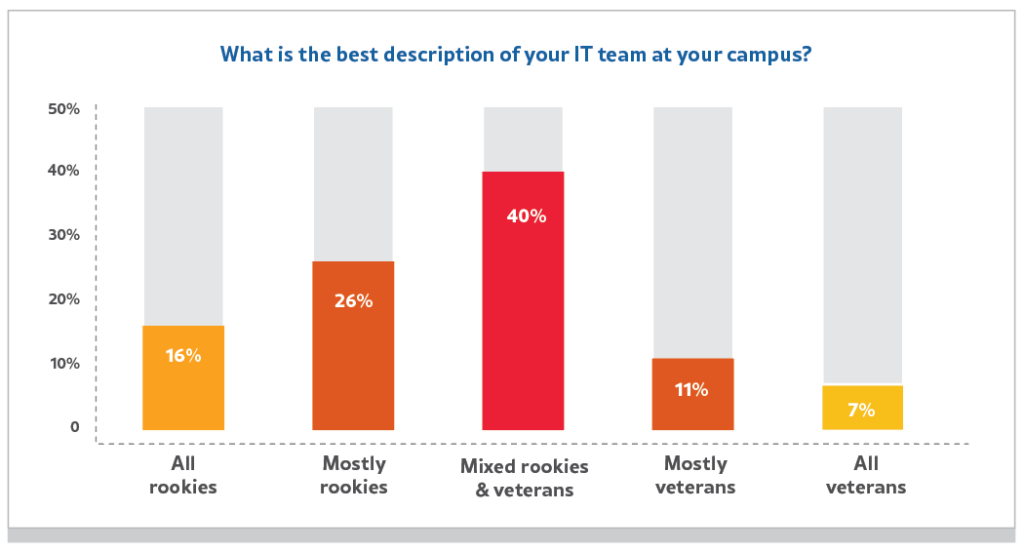

GETTING SMARTER ABOUT CAMPUS IT
Technology has come a long way since the days of break/fix IT. Our respondents indicated many internal IT teams are not equipped to keep up with the pace of innovation, especially as roles are left unfilled and turnover rises. Now more than ever, CIOs must live and breathe four attributes to overcome staffing and expertise shortages, drive smarter IT decisions, and enable innovation:
Agility
You are no longer bound by the old ways of doing things, and you seek new approaches and paradigms that higher ed may have once rejected.
Student-centricity
You understand the link between the college experience, outcomes, health and safety, and life after graduation, and you align your technology investments accordingly.
Strategy
You prioritize strategic projects and forge partnerships to address the cracks (or chasms) that have been exposed by IT staffing and expertise shortages.
Resilience
You believe in the value of higher education and are invested in creating a legacy of change to digitally transform and modernize your institution with technology.
Diamond-Building
Leading CIOs redirect their resources and energy away from day-to-day operations and move them towards strategic activities that enable them to innovate in service of their institution’s mission.
But to do this, you must align your IT team, business officers, and academic leaders, bringing key leaders across multiple functional areas to the table to define strategic goals and scenario plan, while keeping students at the forefront of your minds and decisions always.
At Apogee, we call this diamond-building (Fig 10). Through our twenty years of working with higher ed, we have developed a process to help institutions build diamonds and ensure that projects have stakeholder buy-in, can move forward quickly, and that the right experts are brought in at the right time. Diamond-building ensures that you can bridge the gap our survey respondents pointed out. It is not enough to have senior leadership support, as 55 percent indicated they do. Making agile decisions about resource allocation is the next step needed to improve long-term IT health.
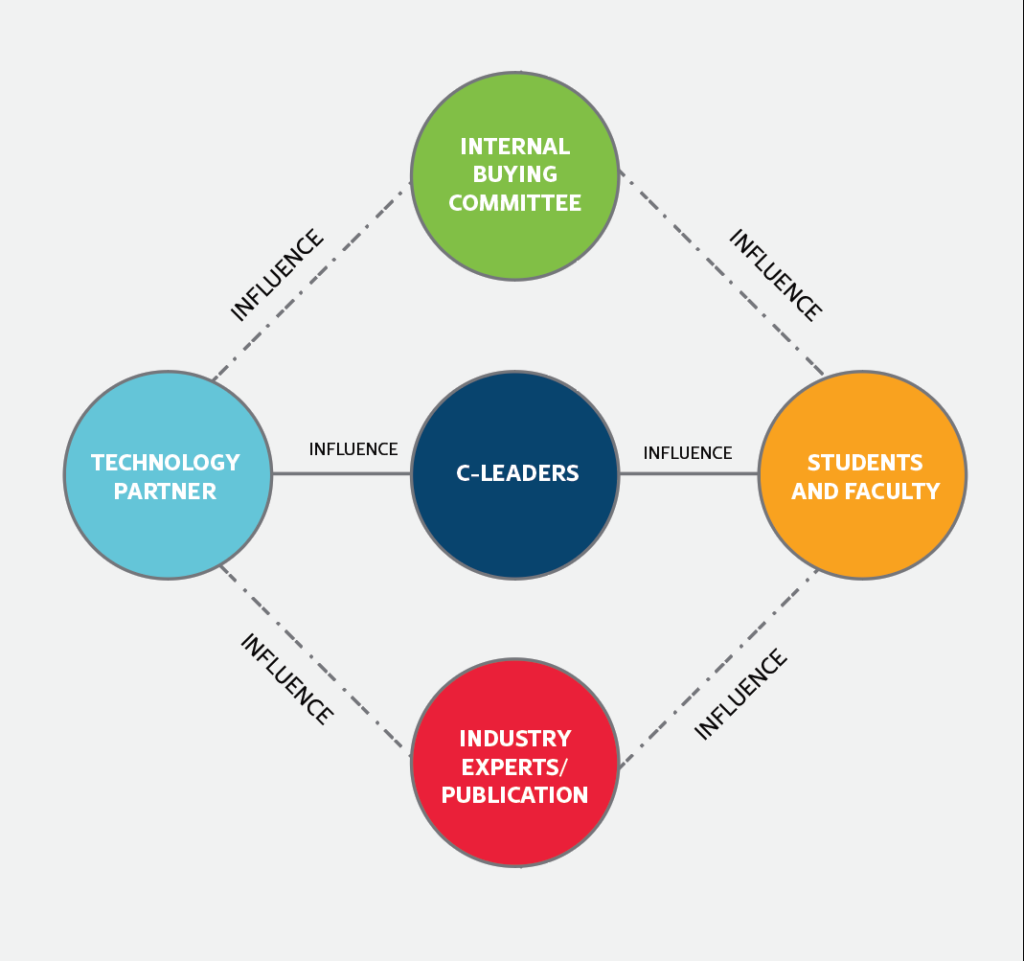
Maslow’s Hierarchy for IT
Another framework that Apogee uses to help our customers make smarter IT decisions is Maslow’s Hierarchy for IT (Fig 11). This framework illustrates where different technologies fit in the needs progression of an organization and the steps that lead to innovation and paradigm shifts. Connectivity – Wi-Fi and wired networks – is a baseline technology. For students, faculty, and staff, a school’s wired and wireless network is as important as the air they breathe. This is non-negotiable. The move to online learning brought this into even sharper focus. You must get connectivity and the next level up the pyramid—stability, security, and information—right.
Once those enabling technologies are operational and financially sustainable, you are freed up to devote the resources, time, and imagination needed to differentiate your school and create paradigm shifts that set up a strong and resilient future. Apogee has developed a worksheet to help you use this framework to determine which in-house IT operations may be slowing down innovation.
Successful CIOs move up the pyramid by partnering with a managed technology services provider (MSP) to gain a deep bench of partner support.
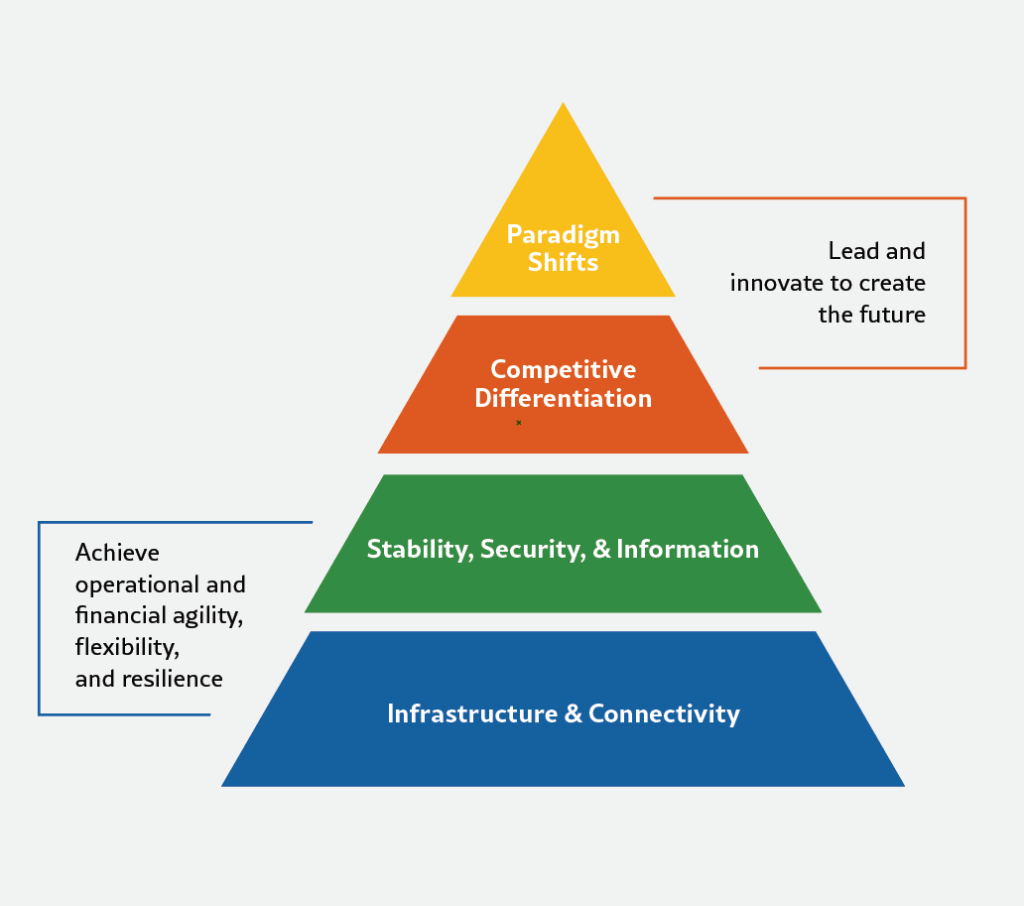
Modernize Ahead of the Curve
As the role of IT shifts from cost center to key contributor to enrollment, retention, persistence, and outcomes, and colleges and universities realize how important IT service delivery performance is to a robust academic experience worthy of student investment, it is no longer possible to get away with IT infrastructure that is not keeping pace with changes in technology or use cases. Nor is it reasonable to expect institutions to throw millions into technology capital expenditures on a regular basis.
Instead, IT must modernize ahead of the curve, with built-in refreshes and futureproofing. CFOs must demand a financial model that is predictable and sustainable. Much like a crystal ball, managed technology services are built to anticipate your IT needs to ensure a modern infrastructure that won’t break the bank. In our 20 years of focus on higher education, we have collected millions of data points on campus IT service delivery, especially student network and device usage, to stay ahead of infrastructure demands and technology innovations. For example, at the University of Kansas, we designed and installed a network before the first iPhone was released, with students carrying only one device. Over time, the school’s network has modernized in a financially sustainable way, now supporting up to ten devices per student.

Emory & Henry College is a small liberal arts school in Emory, Virginia. To compete more effectively with other schools in the area, Emory & Henry created a nursing program designed to meet the immediate needs of its rural Appalachian community. The school invested in network managed services to drive IT modernization and to enable staff to focus on attracting nursing students and serving the community.
“If you haven’t made delivering cutting-edge technology a priority, you better believe others have. Across higher education, universities are engaging in an arms race to recruit students – and great technology is the key weapon in their arsenals.”
– Rick Gaumer, Former Vice President of Business
& Finance, Emory & Henry College
OFFLOAD OPERATIONS, NOT CONTROL
Staffing shortages, gaps in technical expertise, outdated technologies, CAPEX-based procurement models, and slow businesses processes can stonewall your ability focus on strategic initiatives. Offloading these problems to a managed IT services partner instantly frees up the time and headspace needed to work on strategic imperatives.
As the rise of hybrid learning accelerates and small colleges and universities confront enrollment challenges, a robust IT infrastructure is crucial. Campus demands for uncompromising Wi-Fi, a responsive IT service desk, secure and up-to-date devices and applications, and easy access to the network and tools that give that visibility will only increase. The importance of game-changing (and infrastructure-dependent) research will rise. Even occasional failures in IT service delivery risk losing the confidence, and eventually the enrollment, of your students.
One of the greatest benefits of partnering with a managed IT services partner is peace of mind. With you every step of the way, an experienced and knowledgeable partner creates the conditions for high-performing infrastructure and rapid problem resolution, allowing limited in-house staff to focus on high-value initiatives.
These essential services are complemented by a predictable funding model that keeps you fully informed on what you are paying for, along with guaranteed service levels that exceed your ability to deliver otherwise.
Choosing the right managed IT services partner eliminates overly tactical and tedious technology decision-making, provides continuity over the long-term, reduces the risk of staff turnover, and increases your ability to retain the specialized and valuable IT talent you need on strategic projects. A strong partner also provides account stewardship, with dedicated client service managers, monthly conference calls and reports, and onboarding for campus users.
It is important to note that a strong managed IT services provider is an extension of your IT team and not a replacement for it. At Apogee, we believe that you should offload operations, not control. We wear your colors, understand your culture, and are key to executing your strategy, but you remain in charge. A good partner addresses your common operational tasks on your behalf with a deep bench of support so you can let your in-house talent capture value.
The Four Fits
When choosing a managed IT services partner, there are several key factors to evaluate, including the provider’s SLA structure, their innovation roadmap and futureproofing methodology, their reliability metrics, and demonstrable time to value. It is also useful to probe the provider’s proof of velocity in solving problems and driving transformation.
At Apogee, we design and deploy major initiatives in weeks or months that can take campuses up to three years. Partnering with Apogee creates a long-term relationship with a strategic resource who can not only modernize and optimize your IT in the short term, but deliver lasting, legacy-creating value for your institution. Finding a partner who truly gets higher education is critical to successfully supporting or addressing your mission, business goals and model, constraints, and aspirations.
Using the Four Fits to Evaluate an MSP
Apogee recommends using a framework called the Four Fits to determine whether a technology partner is the right fit for your institution (Fig 12).
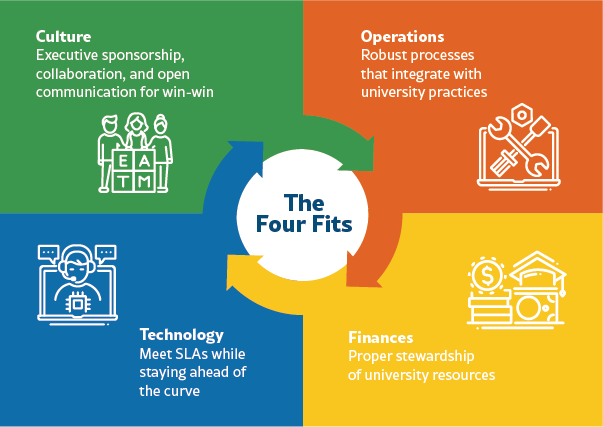
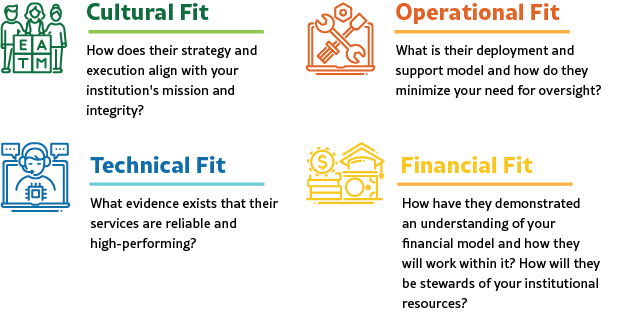
We have developed a worksheet that you can use to rank potential managed technology services partners along these dimensions. The worksheet also contains a SWOT analysis to dive deep into criteria for selecting the right partner.

LET’S TALK
The most successful small colleges and universities will be those that take a focused and strategic approach to innovating on behalf of the next generation of students. Overcoming IT staffing and expertise gaps requires getting smarter about IT and taking a new approach to partner with an expert who gets higher education. The time to act is now. To begin a conversation about the many ways Apogee can help you navigate IT challenges quickly and with confidence, contact an Apogee higher education expert here.
